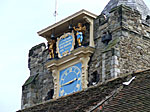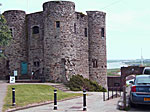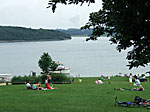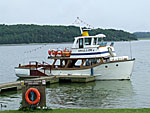Frank's travels around Britain 2006.
Rye, the Cinque Port.

 The second jaunt out and I'm
back to the south coast & looking at a lovely place, recommended by the guy at
the Travel Lodge, as a town to visit. The Confederation of Cinque Ports
(pronounced sink ports) is a historic group of coastal towns in Kent and
Sussex, at the furthest eastern end of the English Channel where the crossing to
the continent is narrowest, originally formed for military and trade purposes,
but now entirely ceremonial. The name is Norman French for five ports -
the five being Hastings, New Romney, Hythe, Dover, and Sandwich. They are
supported by the two 'antient towns' of Rye and Winchelsea, whose councils have
held a long standing tradition of maintaining defence contingents for the realm
of England.
The second jaunt out and I'm
back to the south coast & looking at a lovely place, recommended by the guy at
the Travel Lodge, as a town to visit. The Confederation of Cinque Ports
(pronounced sink ports) is a historic group of coastal towns in Kent and
Sussex, at the furthest eastern end of the English Channel where the crossing to
the continent is narrowest, originally formed for military and trade purposes,
but now entirely ceremonial. The name is Norman French for five ports -
the five being Hastings, New Romney, Hythe, Dover, and Sandwich. They are
supported by the two 'antient towns' of Rye and Winchelsea, whose councils have
held a long standing tradition of maintaining defence contingents for the realm
of England.

 You are first struck by the height of
the town & secondly by how far it is from the sea! Perched on a hill,
overlooking the River Rother and Romney Marsh, its the sort of place you thought
existed only for tourists & film sets. With enchanting cobbled streets, medieval
church and beautifully preserved historic houses from medieval, Tudor and
Georgian times, Rye tries hard to look suspended in time and has a unhurried
atmosphere. It is a very attractive town,
obviously a centre for tourism, and rightly so. It is full of shops
selling very expensive stuff you didn't even know you needed. The cafes are
excellent, selling very good, slightly middle class food at not extortionate
prices. The one I used by the church was brilliant. Fresh filter coffee and a
very nice sandwich for around £4. I'm afraid the car parks sting a little,
as most towns now.
You are first struck by the height of
the town & secondly by how far it is from the sea! Perched on a hill,
overlooking the River Rother and Romney Marsh, its the sort of place you thought
existed only for tourists & film sets. With enchanting cobbled streets, medieval
church and beautifully preserved historic houses from medieval, Tudor and
Georgian times, Rye tries hard to look suspended in time and has a unhurried
atmosphere. It is a very attractive town,
obviously a centre for tourism, and rightly so. It is full of shops
selling very expensive stuff you didn't even know you needed. The cafes are
excellent, selling very good, slightly middle class food at not extortionate
prices. The one I used by the church was brilliant. Fresh filter coffee and a
very nice sandwich for around £4. I'm afraid the car parks sting a little,
as most towns now.
I found a lovely lake & reservoir called Bewl Water. A sort of country park with lots of space so it never seemed over crowed, a boat for trips out, Sailing, windsurfing, powerboats, Fly fishing, picnic areas and lovely wooded glades. The dedicated walkers/cyclists have a 12.5 mile route round the lake.
Kent is an area with limited water supplies. More than sixty years ago engineers
were already identifying that supplies would not be adequate to meet the needs
of future generations. A massive project to develop water supplies in the region
was developed, i ncluding the construction of the Bewl Water reservoir, Yalding
pipeline and Burham Water Supply Works.
ncluding the construction of the Bewl Water reservoir, Yalding
pipeline and Burham Water Supply Works.
Bewl Valley was identified as the best place for a reservoir as it was able to store more water than anywhere else in the region. Sandstone and clay, two of the important materials needed for building the dam, were also available locally. Before the reservoir was built the area was mostly farmland. Work began in 1973 when a woodland was cleared, roads were rerouted and a number of historic houses were dismantled and rebuilt elsewhere. Next the half-mile long dam embankment and two towers were built. In the Summer of 1974 the first water was pumped through the pipes into the reservoir. It took 31,300 million litres of water to fill the reservoir and the project was completed in 1975.
Links for information on this page:
